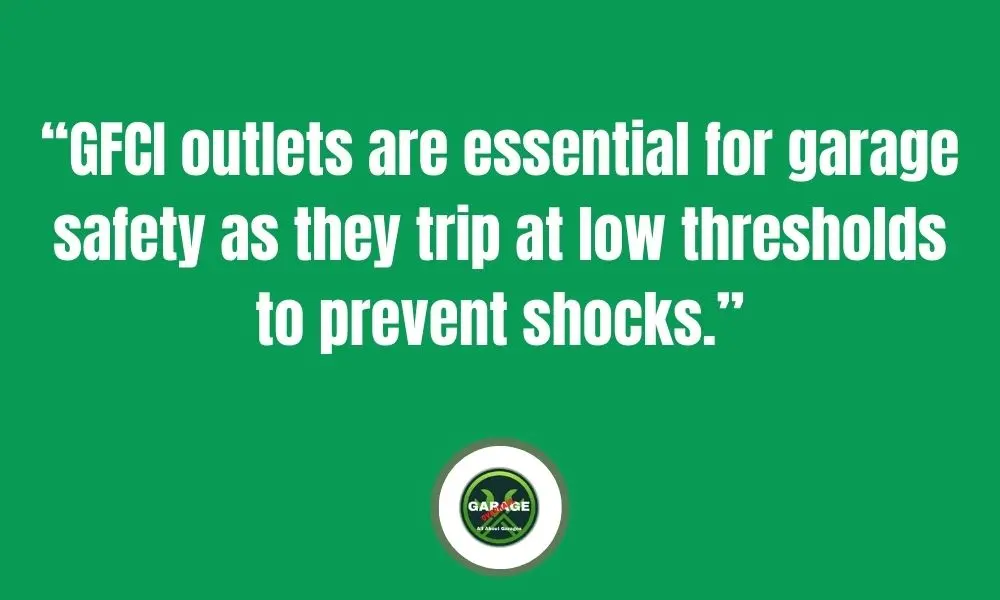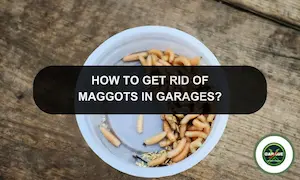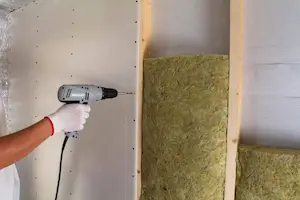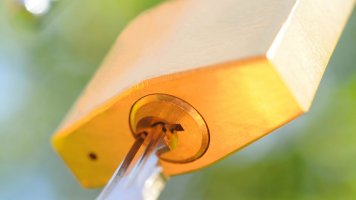Garage Safety Tips: Managing Garage Dangers And Hazards
This post contains affiliate links.

Your garage can be a versatile space, but it’s also home to various dangers and hazards. The potential for accidents is high, from carbon monoxide poisoning and fire risks to electrical issues and chemical exposures. What are some garage safety tips to practice at home?
Some good garage safety tips include:
- Ensure your garage is well-ventilated.
- Keep the garage tidy to reduce fire hazards and tripping risks
- Use approved containers for gasoline, propane, and chemicals.
- Check wiring, outlets, and extension cords for damage.
- Place carbon monoxide and smoke detectors in and near the garage
- Regularly service tools and mechanical equipment
- Keep a fire extinguisher, first aid kit, and personal protective equipment accessible.
This article provides essential garage safety tips to help you identify and mitigate these risks. You can transform your garage into a safer, more functional area by implementing proper steps.
Learn how to protect your home and loved ones from common garage dangers.
Garage Hazards And Safety Tips
| Hazard | Description | Prevention |
| Carbon Monoxide Poisoning | Odorless gas buildup from running vehicles or fuel-burning appliances, even with garage doors open. | Keep garage door fully open when running vehicles, install carbon monoxide detectors. |
| Fire Hazards | Flammable liquids, electrical malfunctions, and clutter. | Store flammable items in approved containers, maintain electrical systems, reduce clutter. |
| Electrical Hazards | Faulty wiring, overloaded circuits, and frayed cords. | Use GFCI outlets, avoid permanent use of extension cords, and organize the space. |
| Garage Door Malfunctions | Door may fall due to malfunctioning components, risking injury or allowing break-ins. | Regular maintenance of springs, cables, and sensors, and ensure door functionality. |
| Explosion Hazards | Caused by flammable materials | Store flammable materials safely, ensure good ventilation. |
| Poor Lighting | Insufficient illumination leads to tripping, hidden spills, and fire risks. | Install multiple light sources (MPI system) for better visibility. |
| Clutter and Mess | Tripping hazards and potential fire risks from disorganized items. | Use shelving units, pegboards, and regular decluttering. |
| Chemical Exposure | Health risks from paints, solvents, pesticides, and automotive fluids. | Store chemicals in original containers, use lockable cabinets, and ensure good ventilation. |
| Vermin and Pests | Attracts pests that can cause structural damage and health issues. | Seal entry points, store food in airtight containers, and maintain cleanliness. |
| Water Leaks and Mold | Water intrusion leads to mold growth and respiratory issues. | Regular inspections, proper sealing, and use of dehumidifiers. |
| Dangerous Tools | Improperly stored or used tools can cause injuries. | Store tools on racks or in toolboxes, unplug when not in use, and use protective gear. |
| Oil and Grease Spills | Slip-and-fall accidents and fire risks from spills during maintenance tasks. | Proper storage, use spill trays, and clean spills immediately. |
| Dust Accumulation | Health risks and fire hazards from accumulated dust. | Regular cleaning, proper ventilation, and use of dust covers. |
| Asbestos Exposure | Health risks from disturbed asbestos in old building materials or automotive parts. | Test for asbestos, use protective gear, and avoid disturbing materials. |
| Heater Malfunctions | Fire, carbon monoxide poisoning, and explosions from improper heater use. | Professional installation, regular maintenance, and proper ventilation. |
| Insufficient Ventilation | Buildup of harmful fumes and moisture affecting health and safety. | Install exhaust fans, ensure proper airflow, and use carbon monoxide detectors. |
Carbon Monoxide Poisoning
Carbon monoxide (CO) hazards in a garage are a serious concern. This colorless, odorless gas can build up quickly and pose significant health risks.
Running your car engine inside the garage, even with open doors, can create dangerous CO levels. You might think an open door is enough ventilation, but CO can accumulate rapidly.
Consider a scenario where you start your car to warm it up on a cold morning. The engine produces CO; without proper ventilation, the gas can seep into your home.
This invisible threat can cause symptoms like:
- dizziness,
- headaches, and
- nausea.
In severe cases, it can lead to unconsciousness or even death.
Fuel-burning appliances are another source of CO. Heaters, generators, and power tools can emit this gas, especially if they are not maintained properly.
Imagine using a generator during a power outage. If placed in the garage, CO levels can rise quickly, endangering anyone nearby.
To prevent CO hazards, always ensure your garage is well-ventilated. Never run your car or any fuel-burning appliance in a closed or partially closed garage.

Install carbon monoxide detectors (paid link) in the garage and near any doors leading into your home. These detectors can alert you to dangerous CO levels before they become life-threatening.
Regular maintenance of vehicles and appliances is crucial. Check for exhaust system leaks in your car and ensure all fuel-burning devices are in good working order. A small exhaust leak can release CO into your garage, creating a hazardous environment.
Using a remote starter for your car can also help. Start your vehicle from outside the garage, allowing it to run safely in an open space. This reduces the risk of CO buildup inside your garage.
Fire Hazards
Fire hazards in a garage often arise from a combination of:
- flammable liquids,
- electrical malfunctions, and
- clutter.
Flammable liquids and chemicals are common in most garages. Gasoline, oils, paints, and propane are highly combustible. If stored improperly, they can easily ignite from an open flame or even a hot piece of metal.
You should always use approved containers and store these flammable items away from heat sources. For optimal safety, keep these containers in a shed away from your home and family.
Electrical equipment is another significant fire hazard in a garage. Faulty wiring, overloaded circuits, and frayed extension cords can all spark a garage fire.
Using power tools unsupervised or with improper safety measures can also be dangerous. Ensure a qualified electrician inspects your garage’s electrical systems, especially if your home is older.
Garage clutter can turn your space into a fire waiting to happen. Many things can easily tip over and catch fire, like:
- Piles of cardboard boxes,
- oily rags, and
- household chemicals.
These items also block walkways, leading to tripping hazards. To keep your garage safe, organize it with storage cabinets and racks. Lock hazardous materials in a cabinet to prevent accidental contact.
Fire safety in a garage is not complete without proper equipment. Install a fire extinguisher (paid link) rated for flammable liquids and electrical fires. Knowing how to use it with the P.A.S.S. method (Pull, Aim, Squeeze, Sweep) can help you stay safe in a fire.
While smoke alarms are not recommended in garages due to temperature fluctuations, they should be installed on every level of your home.
Electrical Hazards
Electrical hazards in a garage are a serious concern that can lead to severe consequences if not addressed. Older homes are particularly vulnerable to these hazards as their garages often need electrical updates.
For starters, standing on concrete, a known electrical conductor, while handling electrical equipment increases the risk of electrical shock.
GFCI outlets are essential for garage safety as they trip at low thresholds to prevent shocks. You should ensure all electrical outlets, including those for garage door openers, are equipped with GFCI protection.

Extension cords are another common hazard. They are often used temporarily but end up becoming a permanent solution. This is a fire hazard waiting to happen.
Instead, install permanent wiring for tools and appliances. Also, check all cords for fraying or damage, and never use staples or nails to attach them to walls or baseboards.
Clutter in your garage can exacerbate electrical hazards. Keep your garage organized to prevent tripping hazards and allow easy access to electrical panels. D
Dispose of oily rags and other flammable materials properly, and store hazardous chemicals in locked cabinets. Propane tanks and other combustible items should be stored away from electrical sources and open flames.
Explosion Hazards
Explosion hazards in a garage are more common than you might think. One major cause is the improper storage of flammable materials.
If improperly handled, gasoline, propane, and even certain cleaning agents can create an explosive environment. Imagine storing a can of gasoline near a heater. The heat can cause the gas to vaporize, creating a highly flammable air mixture.
Electrical issues are another culprit. Faulty wiring or overloaded circuits can spark and ignite flammable vapors.
Have you ever plugged in too many tools at once and noticed the outlet feeling warm? That’s a warning sign. Over time, the wiring can degrade and lead to dangerous situations.
Mechanical failures in equipment also pose risks. Compressors and other machinery can build up pressure, which can lead to an explosion if the pressure relief mechanisms fail.
This is especially true if you’re working with equipment that hasn’t been maintained regularly.
Preventing these hazards starts with awareness and proper storage. Keep flammable liquids in approved containers and away from heat sources.
A metal cabinet designed for flammable storage is a worthwhile investment. Also, ensure your garage is well-ventilated. This helps dissipate any flammable vapors that might accumulate.
Regular maintenance of electrical systems is crucial. Inspect your wiring and outlets periodically, especially if you notice anything unusual, like flickering lights or warm outlets. Using surge protectors and not overloading circuits can also mitigate risks.
For mechanical equipment, follow the manufacturer’s maintenance schedule. Check pressure relief valves and other safety features regularly.
Garage Door Malfunctions
A garage door hazard poses serious risks to both safety and security in your garage. One primary concern is the potential for the door to suddenly fall due to malfunctioning components such as springs or pulleys.
Garage doors can weigh hundreds of pounds, and if the springs give out, the door could slam down, causing severe injuries or even fatalities to anyone underneath.

Garage doors that won’t close properly also present significant security risks. A door that doesn’t fully close leaves your garage and, by extension, your home vulnerable to break-ins.
Thieves can easily exploit this gap to access your personal property or even pose a danger to your family.
There are several reasons why these hazards can occur. Over time, components like springs, cables, and tracks can wear out or become misaligned. Regular use stresses these parts, making them prone to breaking down.
Environmental factors such as dirt, debris, and weather conditions can cause sensors to malfunction, preventing the door from operating correctly.
Preventing these hazards involves regular maintenance and timely repairs. Schedule inspections to check the condition of:
- springs,
- cables,
- rollers, and
- other moving parts.
Ensuring these components are clean, well-lubricated, and properly aligned can extend their lifespan and functionality.
If your garage door exhibits unusual noises, slow operation, or jerky movements, it’s crucial to address these immediately to prevent more severe problems.
Installing and maintaining safety features like photo-electronic sensors can also prevent accidents.
These sensors detect objects in the door’s path and stop the door from closing, thus avoiding injuries and damage. Ensuring these sensors are clean and aligned is key to their proper function.
Poor Lighting
Poor lighting in a garage can create numerous hazards that compromise safety. One significant risk is tripping hazards caused by garage clutter.
Without proper lighting, you might not see scattered tools, extension cords, or other items on the floor, leading to slips and falls.
Moreover, inadequate lighting can hide spills of hazardous chemicals or flammable liquids, increasing the risk of fire and other accidents.
Many garages are designed as secondary spaces, which are often neglected in home improvement projects. They might rely on a single light bulb, which isn’t sufficient to illuminate the entire area.
Over time, this inadequate setup worsens as bulbs burn out or become dust-covered, reducing light levels.
To prevent poor lighting hazards in your garage, consider using a Multi-Point Illumination (MPI) system that provides multiple light sources. This will ensure that every corner of your garage is well-lit, reducing shadows and making it easier to spot hazards.
Clutter and Mess
Clutter and mess in a garage can become serious hazards if left unchecked. It’s easy to overlook a pile of tools or a stack of old boxes, but these seemingly harmless items can lead to accidents or even fires. You might wonder how such chaos starts.
Often, it begins with a lack of organization. Garages are catch-all spaces where everything from seasonal decorations to power tools ends up. Over time, items accumulate, and chaos ensues without a system in place.
Imagine tripping over a garden hose while carrying heavy equipment or stumbling over loose nails scattered on the floor. These are real dangers that clutter creates.
Another factor is the tendency to procrastinate. You think you’ll get to organizing the garage next weekend, but weekends come and go, and before you know it, the mess has doubled.

Many of us face this scenario. And let’s not forget the ‘just in case’ mentality. Holding onto items because you might need them someday adds to the clutter.
Preventing this hazard starts with creating a plan. Invest in sturdy shelving units to keep items off the floor. Pegboards are great for tools, providing easy access and visibility.
Label containers so you know what’s inside without opening them. Set aside time each month to declutter. It doesn’t have to be a massive overhaul; even fifteen minutes can make a difference.
Remember to dispose of items you haven’t used in a year. This simple guideline helps keep unnecessary items from piling up.
Also, consider the layout of your garage. Frequently used items should be easily accessible, while rarely used items can be stored higher up or towards the back. These steps transform your garage from a cluttered hazard into a functional and safe space.
Chemical Exposure
Chemical exposure in a garage poses a serious hazard that many overlook. Garages often house a variety of chemicals, such as:
- paints and solvents,
- pesticides, and
- automotive fluids.
These substances can cause significant health issues if not handled correctly. It’s easy to see how this can happen. We store chemicals in the garage because it’s convenient, but often without proper safety measures.
Picture this: you’re working on a project and accidentally knock over a can of paint thinner. The fumes fill the garage, and you start to feel dizzy. That’s a clear sign of chemical exposure.
One common mistake is improper storage. Chemicals must be kept in original containers, with labels intact, to ensure you know what you’re dealing with.
Mixing different chemicals, even accidentally, can create dangerous reactions. Careless individuals may store bleach and ammonia close together, leading to a toxic gas release when they are accidentally mixed.
Preventing chemical exposure starts with proper storage. Use lockable cabinets to keep chemicals out of reach of children and pets. Ensure the area is well-ventilated. Install a ventilation fan if necessary, especially if you use chemicals frequently.
Always wear protective gear when handling chemicals, like:
- gloves,
- goggles, and
- masks.
This simple step can prevent direct contact and inhalation of harmful substances.
Check for leaks or damaged containers regularly. Properly dispose of old or unused chemicals, following local hazardous waste disposal guidelines.
Never pour them down the drain or throw them in the trash. Creating a dedicated space for chemicals away from living areas and food storage is crucial.
Vermin and Pests
Vermin and pests in a garage can create a significant hazard often underestimated. Garages, with their dark corners and abundance of stored items, provide an ideal environment for these unwelcome guests.

You might find mice, rats, spiders, or even termites living among your tools and boxes.
This problem usually arises from the easy access and ample hiding spots a garage offers. These pests can chew through fabric and wires, creating a mess and a potential fire hazard. Termites can also infest wooden shelving in her garage, causing structural damage.
Food sources can attract pests. Birdseed, pet food, or remnants from your latest DIY project can lure them in. Garages that aren’t regularly cleaned provide these creatures with an ideal habitat.
Cluttered spaces give pests places to hide, making it harder to notice their presence until significant damage has occurred.
Preventing vermin and pest hazards requires a proactive approach. Start by sealing any gaps or cracks in the garage structure. Mice can squeeze through tiny openings, so be thorough. Use steel wool or caulk to block these entry points.
Store food in airtight containers. This includes pet food, birdseed, or other items that might attract pests.
Keep your garage clean and organized. Sweep the floor regularly and remove any spider webs. Clear out the clutter, as piles of unused items make perfect hiding spots for pests.
Set traps or use repellents as a preventive measure. There are humane traps for catching mice and non-toxic sprays for deterring insects. Inspect your garage regularly for signs of pests, like:
- droppings,
- chew marks, or
- nests.
Water Leaks and Mold
Water leaks and mold in a garage present hazards that can compromise your safety and health. Garages, often exposed to the elements, are prone to water intrusion. This can lead to mold growth, creating a potentially toxic environment.
Water leaks typically occur due to poor sealing, damaged roofs, or faulty plumbing. Over time, leaks can worsen, and mold starts growing on the walls and ceiling. This mold causes respiratory issues for his family and damages stored items.
Humidity is another factor. Garages that aren’t climate-controlled can become humid, especially in wet seasons. This moisture can seep into boxes, fabrics, and other porous materials, creating a breeding ground for mold.

Preventing water leaks and mold starts with regular inspections. Check your garage for signs of water intrusion. Look for stains on the walls and ceiling, and inspect the floor for dampness.
Ensure your roof and walls are in good condition. Seal any gaps or cracks that could let water in.
Proper ventilation is crucial. Install vents or a dehumidifier to reduce humidity levels. Keep your garage well-ventilated, especially after it rains. Use fans if necessary.
Storing items off the floor can prevent water damage. Shelving units keep your belongings dry and allow for easy cleaning and inspection.
Use moisture-resistant materials. Paint the walls and floor with mold-resistant products. This adds an extra layer of protection. If you find mold, act quickly. Clean it with appropriate solutions and address the source of moisture.
Dangerous Tools
Dangerous tools in a garage can present significant hazards if not handled or stored properly. Power tools, sharp implements, and heavy equipment are essential for many DIY projects but can cause severe injuries.
Understanding how these hazards arise and how to prevent them is crucial for maintaining a safe environment.
One common reason for tool-related accidents is improper storage. When left lying around, tools can easily be tripped over or cause cuts and bruises.

Another issue is using tools without proper training or protective gear. You might feel confident using a power drill or circular saw, but you’re putting yourself at risk without safety goggles, ear protection, and gloves.
Preventing these hazards starts with organization. Store tools properly on:
- racks,
- shelves, or
- in toolboxes.
This keeps them off the floor and out of harm’s way. Pegboards are great for keeping frequently used tools visible and accessible. Always unplug power tools when not in use to prevent accidental activation.
Regular maintenance is essential. Inspect your tools for wear and tear, replace damaged parts, and ensure everything functions correctly. A malfunctioning tool can be just as dangerous as an improperly used one.
Training is also vital. Take the time to learn how to use each tool correctly. Watch tutorials or read manuals to understand their specific safety features.
Never bypass safety mechanisms, no matter how experienced you are.
Lastly, always use protective gear. Gloves, goggles, ear protection, and appropriate footwear can prevent many common injuries. Keep a first aid kit in your garage for quick access in case of accidents.
Oil and Grease Spills
Oil and grease spills in a garage can create serious hazards, including slip-and-fall accidents and fire risks. Garages often house vehicles and machinery that use these substances, making spills common.
Understanding why these spills happen and how to prevent them is crucial for maintaining a safe workspace.
Spills usually occur during routine maintenance tasks. For example, you might change your car’s oil or lubricate a machine, and a little carelessness can lead to a mess.
Another cause is improper storage of oil and grease containers. If these containers aren’t sealed correctly or are stored in unstable positions, they can tip over.
Preventing these hazards starts with proper storage. Keep oil and grease in well-sealed containers. Store them on lower shelves to minimize the risk of falling. Use spill trays or mats designed to contain leaks.
Take precautions when working with oil and grease. Use funnels and spouts to control the flow and minimize spills. Keep rags or absorbent pads handy to clean up any drips immediately.
If a spill does happen, address it right away. Absorbent materials like cat litter or commercial spill kits can soak the liquid.
Regularly clean your garage floor to remove any residual oil or grease. This prevents buildup and reduces the risk of slips. Consider using a non-slip floor coating for added safety.
Another tip is to create a dedicated area for oil and grease work. Use this space for maintenance tasks to contain potential spills.
Dust Accumulation
Dust accumulation in a garage can become a significant hazard if not managed properly. Garages often house various tools, vehicles, and stored items that can generate and collect dust over time.
This dust can pose health risks, affect equipment performance, and even create fire hazards.
Dust builds up due to the nature of activities in a garage. Sanding, sawing, and other DIY tasks produce fine particles that settle on surfaces.
Another reason for dust accumulation is the storage of seldom-used items. Boxes, old furniture, and tools gather dust when left undisturbed.
Regular cleaning is essential to prevent dust accumulation. Sweep and vacuum your garage frequently, especially after completing projects that generate dust. A vacuum with a HEPA filter can help capture fine particles more effectively.
Proper ventilation is crucial. Install exhaust fans or open windows and doors while working to reduce dust buildup. This not only helps in removing dust but also improves air quality.
Consider using dust covers for items that are not frequently used. These covers can protect your belongings from dust and make cleaning easier. I’ve found that simple plastic sheets or specialized covers work well.
Another tip is to organize your garage to minimize dust collection points. Keep items off the floor and use shelves or cabinets. This makes cleaning easier and reduces the surfaces where dust can settle.
It is also important to maintain your tools and equipment. Clean them after use to prevent dust from affecting their performance.
Asbestos Exposure
Asbestos exposure in a garage can be a significant health hazard, especially if your home was built before the 1980s. Asbestos was commonly used in building materials for its fire-resistant properties.

When these materials deteriorate or are disturbed, asbestos fibers can be released into the air and inhaled, posing serious health risks.
Asbestos can become a hazard in your garage through old insulation, floor tiles, or roofing materials. You might decide to renovate or simply move things around, unknowingly disturbing asbestos-containing materials.
Another common source is automotive parts. Brake pads, clutches, and gaskets in older vehicles might contain asbestos. If you work on these parts without proper precautions, you risk exposure.
Preventing asbestos exposure starts with awareness. Before starting any renovation or repair work in your garage, check if your home might contain asbestos.
If in doubt, hire a professional to test for asbestos. They can identify and safely remove any hazardous materials.
When working on older vehicles, always check if the parts contain asbestos. Use appropriate protective gear, such as masks and gloves, to minimize exposure.
It’s also wise to keep the garage well-ventilated and clean any dust with a damp cloth to avoid stirring up asbestos fibers.
Regular maintenance and cautious handling of materials are crucial. Avoid sanding, drilling, or cutting materials that might contain asbestos.
Taking these precautions can significantly reduce the risk of asbestos exposure in your garage, ensuring a safer environment for you and your family.
Heater Malfunctions
Heater malfunctions in a garage can be hazardous, posing risks like fire, carbon monoxide poisoning, and even explosions.
Many people use heaters to keep their garages warm during colder months, but if they are not properly maintained or used, they can become dangerous.
A common reason for heater malfunctions is improper installation. You might install a heater yourself, thinking it’s a simple task. However, you could make mistakes that lead to gas leaks or electrical problems without proper knowledge.
Neglecting regular maintenance is another issue. Over time, heaters accumulate dust and debris, clogging vents and filters, leading to overheating.
Always follow the manufacturer’s installation instructions or hire a professional to prevent heater malfunctions. Ensure your heater is appropriate for the garage space and properly vented. Regular maintenance is crucial.
Clean the heater regularly and check for any signs of wear or damage. Replace filters as recommended by the manufacturer.
Install a carbon monoxide detector in your garage. This device can save lives by alerting you to dangerous levels of this odorless gas. Keep flammable materials away from the heater. Items like gasoline, paint, and cleaning supplies should be stored at a safe distance.
Lastly, never leave a heater unattended. Turn it off when you leave the garage or when it’s not in use. Taking these precautions can significantly reduce the risk of heater malfunctions in your garage, ensuring a safe and warm environment during the colder months.
Insufficient Ventilation
Insufficient ventilation in a garage can pose serious hazards, affecting both health and safety. Garages often serve as workspaces, storage areas, and even social hubs. Still, poor ventilation can lead to harmful fumes and moisture buildup.
One common reason for poor ventilation is the garage’s design. Many garages are built with limited windows or vents, which restricts airflow. You might notice a musty smell or feel dizzy after spending time in your garage. These are signs of inadequate ventilation.
Using fuel-burning appliances like heaters or power tools can also contribute to poor air quality. These devices produce carbon monoxide, a colorless, odorless gas that can be deadly in high concentrations.
Preventing ventilation hazards involves a few key steps. First, ensure your garage has adequate airflow. Install exhaust fans or open windows and doors to allow fresh air to circulate. If your garage lacks vents, consider adding them.

Regularly check and maintain any fuel-burning appliances. Install a carbon monoxide detector to monitor the air quality. This device can alert you to dangerous levels before they become harmful.
Wear appropriate protective gear like masks and gloves if you use your garage for projects involving chemicals or materials that release fumes. Use products in well-ventilated areas and store them safely to minimize exposure.
Garage Safety Starts From You
Ensuring garage safety requires vigilance and proper management of potential hazards. Addressing risks like carbon monoxide poisoning, fire hazards, electrical issues, and clutter can create a safer environment.
Proper storage of flammable materials, regular electrical systems and equipment maintenance, and adequate ventilation are crucial steps.
Installing detectors for carbon monoxide and smoke and organizing tools and chemicals further enhances safety.
Taking these precautions seriously protects your home and ensures the well-being of your family. Stay proactive and attentive; your garage can be a safe, functional space.






